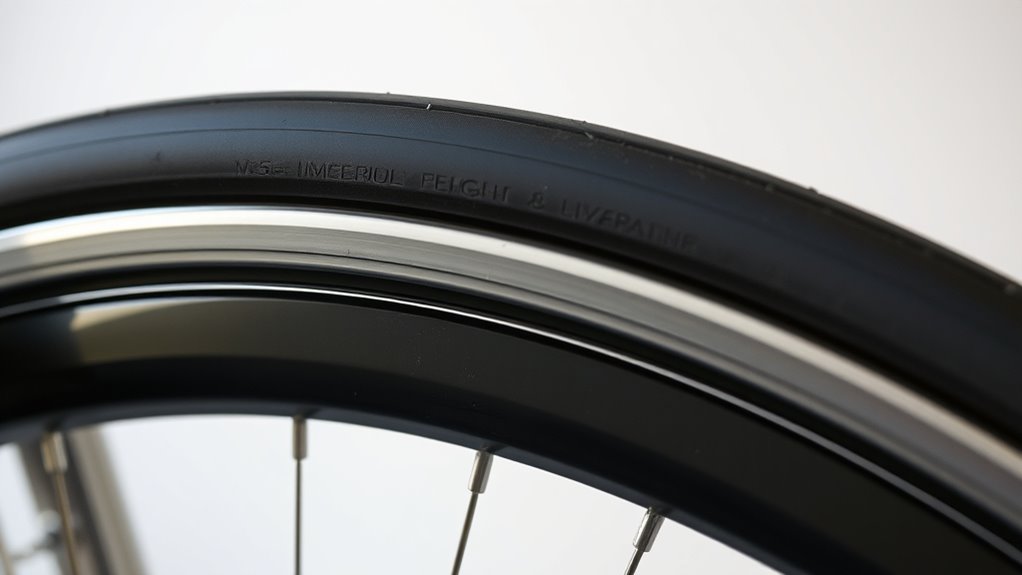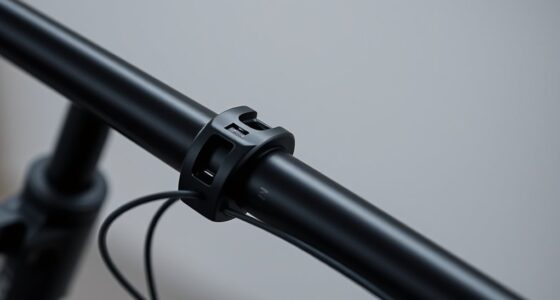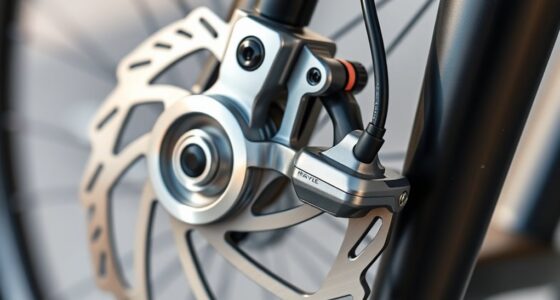To true a wobbly wheel without a truing stand, start by inspecting the rim closely and marking spots that wobble or contact the brake pads. Use a sturdy straight edge or string as a guide, then gently tighten spokes opposite high spots and loosen those at low spots. Make small adjustments and recheck the wheel’s alignment. With patience and care, you can achieve a true wheel—and more tips await if you keep going.
Key Takeaways
- Use a string or straightedge along the rim to identify high and low spots visually.
- Gradually tighten or loosen spokes opposite the wobble to realign the rim.
- Focus on adjusting spokes at the points where the rim deviates, making small, incremental changes.
- Spin the wheel frequently during adjustments to monitor progress and prevent over-correction.
- Check rim contact with brake pads and ensure the wheel remains centered before finalizing.
Assessing the Wobble and Identifying the Issue

Before attempting any repairs, you need to accurately assess the wobble to pinpoint the problem. Spin the wheel and observe how it moves. If the wobble is side to side, it’s likely due to uneven spoke tension or a bent rim. Check for inconsistencies in spoke tension by pressing gently on each spoke with your fingers—loose spokes can cause the wheel to wobble. Examine the rim closely, looking for any bends or dents that may need straightening. Use a visual guide or a makeshift truing method, like placing a marker or string along the rim, to identify where the rim deviates. Regular inspection and understanding of gauge and tension can help prevent future issues. Being familiar with the truing process also enables you to better diagnose issues before they worsen. Additionally, understanding wheel dynamics can assist in maintaining proper alignment over time. Knowing how different spoke patterns influence wheel stability is crucial for effective repairs. Familiarity with proper maintenance techniques can further prolong the lifespan of your wheel and prevent recurring problems.
Preparing Your Workspace and Tools
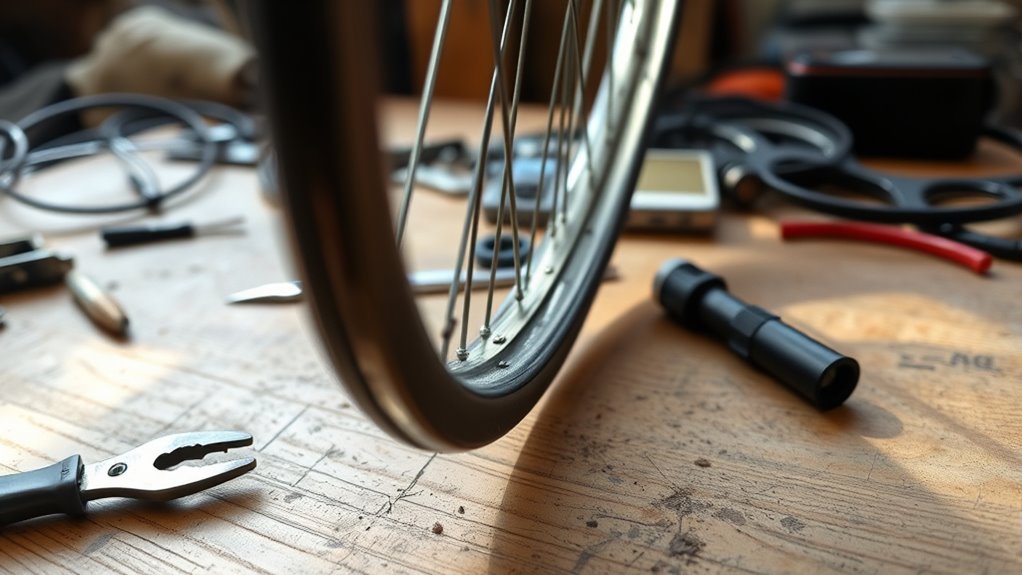
Setting up a clean, well-organized workspace is essential for effectively truing a wheel without a stand. Confirm your work surface is stable and free of clutter to easily access tools and parts. Gather the necessary tools, such as spoke wrenches, pliers, and a marker, and keep spare spokes on hand for spoke replacement if needed. Before starting, check the hub for maintenance issues; lubricate or adjust the hub if it feels rough or loose to prevent further problems during truing. Clear space for removing the wheel and inspecting the rim. Having good lighting helps you see bends and out-of-true spots clearly. Proper preparation ensures you work efficiently, minimizes mistakes, and keeps your wheel in top shape throughout the process. Additionally, ensure your headphones are disconnected to avoid distractions and maintain focus on the task at hand. Incorporating AI-powered tools can further assist in identifying misalignments and guiding adjustments, making the process more precise. Utilizing visual aids, such as a spoke tension meter or a truing stand app, can also improve accuracy and confidence during the process. To further support precise adjustments, understanding Volkswagen Tuning principles can help you better interpret wheel behavior and tuning techniques. Recognizing proper tension in spokes can ensure a durable and true wheel after your adjustments.
Marking the Out-of-True Areas on the Rim

To accurately identify the areas where your wheel is out of true, start by spinning the rim and closely observing it under good lighting. Watch for wobbling or contact with brake pads, which signals uneven tension or a bent rim. Mark the spots where the rim deviates using a small marker or tape. Keep in mind that uneven tire pressure can exaggerate wobbling, so check and adjust it first. Also, note that inconsistent spoke tension causes the rim to shift out of true. As you mark the problem areas, focus on these key points:
- Locations where rim touches brake pads
- Areas with visible rim bends or hops
- Spots where the rim wobbles side to side
- Sections with inconsistent spoke tension
- Areas affected by incorrect tire pressure
These marks will guide your adjustments later, and understanding the importance of spoke tension can help you achieve a more precise wheel true. Additionally, paying attention to the wheel’s structure can help prevent further misalignment and ensure a smoother ride, especially since the integrity of the rim directly impacts overall wheel performance. Recognizing how rim deformation occurs can aid in diagnosing underlying issues and maintaining wheel longevity. Being aware of potential structural damage can help you decide when professional repair might be necessary to ensure safety and durability.
Applying Gentle Adjustments to the Spokes
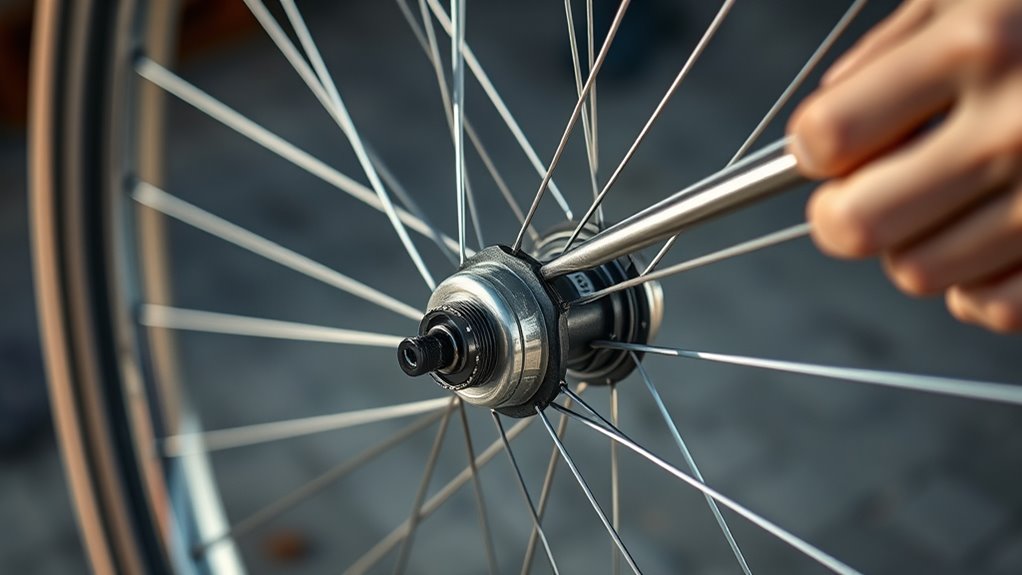
Gently adjusting your spokes is essential to correcting wheel wobble without causing further damage. Focus on maintaining consistent spoke tension to improve rim trueness. If one side is too loose, tighten the spokes gradually, turning the nipple a quarter turn at a time. Conversely, if a spoke is too tight, loosen it slightly to balance tension across the wheel. Always check the rim’s wobble after each adjustment to monitor progress. Avoid over-tightening, which can warp the rim or damage spokes. Incorporating a balanced tension across all spokes ensures a more stable and durable wheel. Aim for small, incremental changes to keep tension even and preserve rim trueness. This careful approach prevents new issues and gradually straightens the wheel. Patience and precise adjustments are key to achieving a true wheel without specialized tools. Incorporating a thorough understanding of wheel maintenance can further improve your skills and results. Paying attention to proper spoke tension can prevent future wobbling issues and extend the lifespan of your wheel. Additionally, understanding the importance of self-directed IRA strategies can help diversify your retirement portfolio and optimize your investments over time.
Using a Reference Edge or String for Alignment

You can use a straight edge or a string to check your wheel’s alignment easily. Make sure the reference touches the rim consistently at multiple points around the wheel. This simple method helps you identify high spots and unevenness without special tools. Incorporating accurate measurement techniques can enhance your troubleshooting accuracy and results. Using a consistent reference point helps in maintaining proper wheel alignment, which is crucial for smooth riding and safety.
Selecting a Straight Edge
When selecting a straight edge for wheel truing, choosing a reliable reference is vital to guarantee accurate alignment. Your straight edge should be sturdy, straight, and easy to handle. Focus on ruler selection that offers good surface smoothness to ensure precise contact with the rim. Avoid warped or bent tools, as they compromise accuracy. Consider these tips:
- Opt for a metal or high-quality plastic straight edge for durability
- Ensure the ruler’s surface is smooth and free of nicks or dents
- Choose a length that comfortably spans the wheel’s diameter
- Verify the straight edge has no warps or bends before use
- Use a ruler with clear, easy-to-read markings for quick assessment
A good straight edge provides a reliable reference, making wheel truing more straightforward and accurate.
Using String for Alignment
Using a string for alignment offers a simple yet effective way to check and correct wheel trueness without specialized equipment. To do this, stretch a string along the side of the rim, ensuring it’s close to the braking surface. The string acts as a visual guide, revealing high or low spots by showing gaps between the rim and the string. Adjust spoke tension accordingly, tightening spokes opposite the high spots and loosening those near low spots. This method helps you identify uneven rim tension and improve rim trueness. Keep checking as you tighten or loosen spokes to maintain an even rim profile. Remember, consistent spoke tension is key to a true wheel, and the string provides a straightforward guide to achieve that.
Ensuring Consistent Contact
To guarantee consistent contact between the rim and the brake pads or a reference edge, it’s vital to establish a reliable alignment guide. Proper brake alignment ensures even contact and smooth braking. Use a string or a straight edge to check the rim’s position relative to your brake pads. Adjust tire pressure to the recommended level, as under-inflated tires can cause wobbling, affecting contact. When aligning, look for these key points:
- Verify the rim is centered relative to the brake pads
- Use a string to trace the rim’s curvature
- Check for even contact at multiple points
- Adjust brake calipers if contact varies
- Confirm tire pressure is ideal for stability
This approach minimizes wobbling and guarantees consistent, reliable brake contact.
Fine-Tuning and Checking Your Progress

After making adjustments, spin your wheel and watch closely for wobbles. If it’s still uneven, make small tweaks and recheck its spin. Keep repeating this process until the wheel runs smoothly without wobbling.
Spin and Observe
Once you’ve made initial adjustments, it’s important to spin your wheel and watch how it behaves. This step helps you assess your wheel truing and spoke tension, ensuring your wheel runs smoothly. As it spins, observe for any wobbling or side-to-side movement. Pay attention to these points:
- How evenly the wheel spins without wobbling
- Any noticeable dips or hops
- Changes in how the wheel contacts the brake pads
- Areas where the rim seems off-center
- Consistency in spoke tension across the wheel
Adjust and Recheck
How can you guarantee your wheel is truly true after making adjustments? The key is to carefully recheck the rim trueness and spoke tension. After tightening or loosening spokes, spin the wheel again and observe any wobble. If the rim still isn’t perfectly straight, make small, precise adjustments to specific spokes, focusing on those causing the wobble. Maintain even spoke tension across the wheel to ensure consistent rim trueness. Recheck the rim’s alignment after each adjustment by spinning it and observing closely. This iterative process helps you refine the wheel’s true shape. Remember, patience is essential. Small, incremental changes combined with frequent rechecks will help you achieve a smooth, true wheel without a truing stand.
Final Inspection and Test Ride
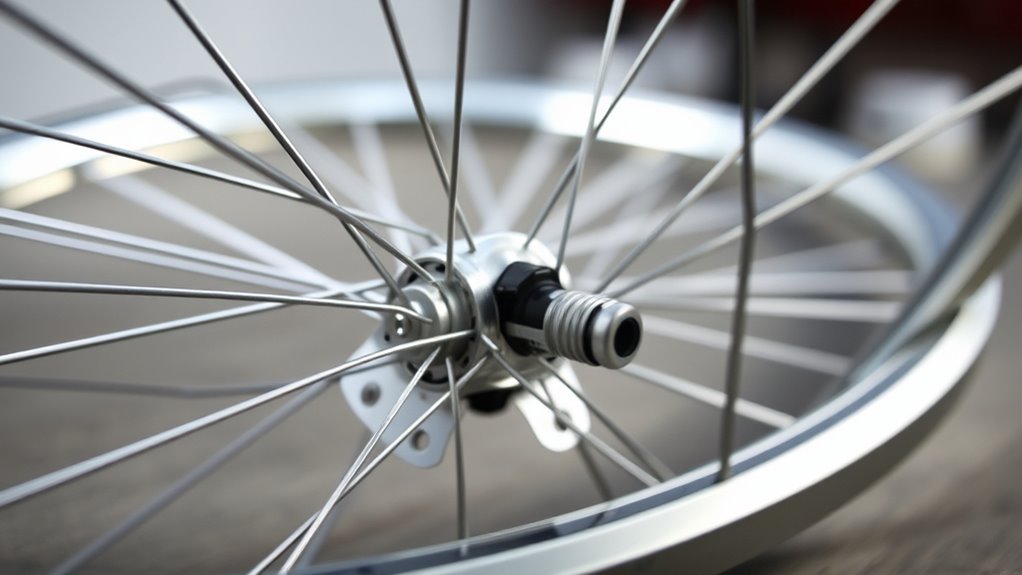
Before you hit the road, it’s crucial to perform a thorough final inspection and test ride to make certain your wheel is properly trued and safe to use. Check the frame alignment to ensure everything lines up correctly and that no new issues have appeared. Confirm tire compatibility by inspecting for proper inflation and even contact with the rim. During your test ride, pay attention to any wobbling, unusual sounds, or handling issues.
Consider these steps:
- Spin the wheel and observe for side-to-side or radial wobbles
- Test brake responsiveness and stopping power
- Ensure quick release or axle nuts are secure
- Check for even tire wear and proper inflation
- Make adjustments if you notice any irregularities
Frequently Asked Questions
Can I Fix a Wobbly Wheel Without Any Special Tools?
You can fix a wobbly wheel without special tools by trying some DIY maintenance methods. Use your hands to spin the wheel and identify the wobble’s location. You might gently loosen and retighten the spokes, then make small adjustments to straighten the wheel. For tool alternatives, a pair of pliers or a spoke wrench can help. While not perfect, these methods can improve wheel stability without needing a truing stand.
How Long Does a Wheel Truing Process Typically Take?
The wheel truing process usually takes about 15 to 30 minutes, depending on how wobbly your wheel is and your experience with wheel maintenance. If you don’t have truing tools, it might take longer, but you can still make adjustments carefully. Using makeshift tools or improvising can help, but for precise results, investing in proper truing tools guarantees your wheel is straight and smooth.
What Are Common Mistakes to Avoid During Truing?
Imagine you’re balancing a tightrope—precision matters. When truing your wheel, avoid common mistakes like neglecting precise spoke tension or disrupting the correct spoke pattern. Over-tightening spokes can warp the wheel, while uneven tension causes wobbliness. Also, don’t rush; patience guarantees accuracy. Keeping an eye on these details helps you maintain a true wheel, preventing future issues and ensuring a smooth ride without needing a truing stand.
Is It Safe to Ride a Wheel That’s Slightly Out of True?
Riding a wheel that’s slightly out of true can be safe for short rides, but it may cause brake rubs and uneven tire pressure, affecting your ride quality. Keep an eye on the wobble, and avoid aggressive riding until you fix it. If the wobble worsens or causes brake issues, it’s best to true the wheel properly. Regular checks prevent further damage and make certain a smoother, safer ride.
How Often Should I Check My Wheel for True Alignment?
Your wheel maintenance routine is the heartbeat of your bike safety, and ignoring it can lead to a catastrophe faster than a speeding bullet. You should check your wheel for true alignment every few rides, especially if you hit rough terrain or notice any wobbling. Regular inspections keep your ride smooth and safe, preventing costly repairs. Staying proactive guarantees your bike stays in top shape and keeps you safe on every adventure.
Conclusion
Even without a truing stand, you can straighten a wobbly wheel by carefully adjusting spokes and checking alignment with a string or edge. Don’t worry if it seems tricky at first—you’ll get better with practice, like tuning a guitar. Just take your time, make small adjustments, and regularly check your work. Before long, your wheel will spin true, ready for smooth rides and confident handling.
